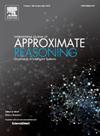基于模糊粗糙颗粒多粒度融合的多视点异常点检测
IF 3.2
3区 计算机科学
Q2 COMPUTER SCIENCE, ARTIFICIAL INTELLIGENCE
引用次数: 0
摘要
近年来,多视图数据在各个领域得到了广泛的应用,由于其在不同视图之间的复杂分布,带来了机遇和挑战。在此类异构数据中检测异常值已成为一个重要的研究问题。现有的多视图异常点检测方法往往依赖于聚类假设、视图之间的两两约束以及关注共识信息的学习,而忽略了视图之间的内在差异。针对上述问题,本文提出了一种基于多粒度模糊粗糙信息融合的离群点检测方法。该方法利用模糊相似关系计算多粒度相似矩阵,将不同粒度的相似矩阵组合成上近似矩阵,构造融合上近似颗粒来检测属性异常。然后使用邻居域概率映射来统一视图之间的邻居关系,允许对一致性和分布差异进行分析,以捕获类异常值。此外,本文采用一种新颖的粗精逼近方法构造上逼近矩阵,进一步提高了属性离群点检测的精度。在多个公共数据集上的实验结果表明,该方法在检测精度和鲁棒性方面普遍优于现有的多视图离群点检测方法。本文章由计算机程序翻译,如有差异,请以英文原文为准。
Multi-view outlier detection based on multi-granularity fusion of fuzzy rough granules
In recent years, multi-view data has seen widespread application across various fields, presenting both opportunities and challenges due to its complex distribution across different views. Detecting outliers in such heterogeneous data has become a significant research problem. Existing multi-view outlier detection methods often rely on clustering assumptions, pairwise constraints between views, and a focus on learning consensus information, which overlook the inherent differences across views. To address the aforementioned issues, this paper proposes an outlier detection method based on the fusion of multi-granularity fuzzy rough information (MGFMOD). The method calculates a multi-granularity similarity matrix using fuzzy similarity relationships, combines similarity matrices from different granularities to form an upper approximation matrix, and constructs fused upper approximation granules to detect attribute anomalies. Neighbor domain probabilistic mapping is then employed to unify neighborhood relationships across views, allowing the analysis of both consistency and distribution differences to capture class outliers. Additionally, this paper employs a novel coarse-to-fine approximation method to construct the upper approximation matrix, further improving the accuracy of attribute outlier detection. Experimental results on multiple public datasets demonstrate that the proposed method generally outperforms existing multi-view outlier detection methods in terms of detection accuracy and robustness.
求助全文
通过发布文献求助,成功后即可免费获取论文全文。
去求助
来源期刊

International Journal of Approximate Reasoning
工程技术-计算机:人工智能
CiteScore
6.90
自引率
12.80%
发文量
170
审稿时长
67 days
期刊介绍:
The International Journal of Approximate Reasoning is intended to serve as a forum for the treatment of imprecision and uncertainty in Artificial and Computational Intelligence, covering both the foundations of uncertainty theories, and the design of intelligent systems for scientific and engineering applications. It publishes high-quality research papers describing theoretical developments or innovative applications, as well as review articles on topics of general interest.
Relevant topics include, but are not limited to, probabilistic reasoning and Bayesian networks, imprecise probabilities, random sets, belief functions (Dempster-Shafer theory), possibility theory, fuzzy sets, rough sets, decision theory, non-additive measures and integrals, qualitative reasoning about uncertainty, comparative probability orderings, game-theoretic probability, default reasoning, nonstandard logics, argumentation systems, inconsistency tolerant reasoning, elicitation techniques, philosophical foundations and psychological models of uncertain reasoning.
Domains of application for uncertain reasoning systems include risk analysis and assessment, information retrieval and database design, information fusion, machine learning, data and web mining, computer vision, image and signal processing, intelligent data analysis, statistics, multi-agent systems, etc.
 求助内容:
求助内容: 应助结果提醒方式:
应助结果提醒方式:


